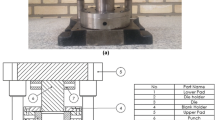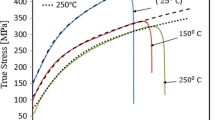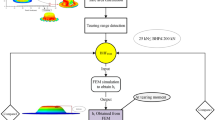Abstract
Punch–die misalignment is one of the factors that can contribute to drawn cup defects such as thinning and tearing. Deep drawing is a closed-die process, and defects can be identified only after the drawing is finished. In this work, the effect of punch–die misalignment severity on the drawing force and wall thickness distribution of electrolytic zinc-coated steel blank (SECC) was investigated. The stress–strain diagram and forming limit diagram of SECC material was determined and simulated using the Hill’48 model. Two conditions of punch–die misalignment were studied: single-axis and multi-axis misalignment. A high punch–die misalignment severity contributes to the increment in the drawing force. Furthermore, wall thickness distribution becomes non-uniform, and the thinning pattern increases due to the greater misalignment severity. For validation, an experiment was conducted on a universal tensile machine.











Similar content being viewed by others
References
Atul ST, Babu MCL (2018) A review on effect of thinning, wrinkling and spring-back on deep drawing process. Proc Inst Mech Eng B J Eng Manuf 233:1–26
Berger M, Zussman E (2002) On-line thinning measurement in the deep drawing process. J Manuf Sci Eng 124(2):420–425
Colgan M, Monaghan J (2003) Deep drawing process: analysis and experiment. J Mater Process Technol 132(1):35–41
Hill R (1948) A theory of the yielding and plastic flow of anisotropic metals. Proc Roy Soc A Math, Phys Eng Sci 193(1033):281–297
Huang Y, Chen J (1996) Influence of the tool clearance in the cylindrical cup-drawing process. J Mater Process Technol 0136(95):4–13
Intarakumthornchai T, Jirathearant S, Thongprasert S, Dechaumphai P (2010) FEA-based optimization of blank holder force and pressure for hydromechanical deep drawing of parabolic cup using greedy search and RSM methods. Eng J 14(2):15–32
Joshi AR, Kothari KD, Jhala RL (2013) Effects of different parameters on deep drawing process: review. Int J Eng Res Technoly (IJERT) 2(3):1–5
Karupannasamy DK et al (2012) Modelling mixed lubrication for deep drawing processes. Wear. Elsevier 294–295:296–304
Kibe Y, Okada Y, Mitsui K (2007) Machining accuracy for shearing process of thin-sheet metals—development of initial tool position adjustment system. Int J Mach Tool Manu 47:1728–1737
Kitayama S, Hamano S, Yamazaki K, Kubo T, Nishikawa H, Kinoshita H (2010) A closed-loop type algorithm for determination of variable blank holder force trajectory and its application to square cup deep drawing. Int J Adv Manuf Technol 51:507–517
Nagda PS, Bhatt PS, Shah MK (2017) Finite element simulation of deep drawing process to minimize earing. World Acade Sci Eng Technol Int J Mechan Mechatronics Eng 11(2):413–416
Ogawa T et al (2016) Analysis of square cup deep-drawing test of pure titanium. J Phys Conf Ser 734(3):032072
Padmanabhan R, Oliveira MC, Alves JL, Menezes LF (2007) Influence of process parameters on the deep drawing of stainless steel. Finite Elem Anal Des 43(14):1062–1067
Patekar S (2015) Optimization of thinning in deep drawing process using grey wolf optimizer algorithm. Int Eng Res J (IERJ) 2:5722–5726
Ramezani M, Ripin ZM (2012) Analysis of deep drawing of sheet metal using the Marform process. Int J Adv Manuf Technol 59(5–8):491–505
Signorelli JW, Serenelli MJ, Bertinetti MA (2012) Experimental and numerical study of the role of crystallographic texture on the formability of an electro-galvanized steel sheet. J Mater Process Tech. Elsevier B.V. 212(6):1367–1376
Slavič J, Bolka Š, Bratuš V, Boltežar M (2014) A novel laboratory blanking apparatus for the experimental identification of blanking parameters. J Mater Process Tech 214:507–513
Szumera J (2003) The metal stamping process: your product from concept to customer, 1st ed. Industrial Press Inc., New York
Tetzel H, Rathmann L, Heinrich L (2016) Simulation accurancy of a multistage micro deep drawing process. J Technol Plasticity 41(1):1–11
Tian S, Feng Y, Gao Y (2015) Design and application of a novel cone-shaped blank holder for precision stamping process. Proc CIRP. Elsevier B.V. 27:309–312
Vairavan H, Abdullah AB (2017) Die-punch alignment and its effect on the thinning pattern in the square-shaped deep drawing of aluminium alloy. Int J Mater Prod Technol 54:147–164
Yang C, Li P, Fan L (2014) Blank shape design for sheet metal forming based on geometrical resemblance. Proc Eng 81:1487–1492
Zein H, el Sherbiny M, Abd-Rabou M, el shazly M (2014) Thinning and spring back prediction of sheet metal in the deep drawing process. J Mater Des 53:797–808
Zoesch A, Wiener T, Kuhl M (2015) Zero defect manufacturing: detection of cracks and thinning of material during deep drawing processes. Proc CIRP. Elsevier 33:179–184
Zorn W et al (2019) Potential of the force distribution measurement in deep drawing processes for increasing the process quality. Int J Mech Eng Robot Res 8(3):449–453
Acknowledgements
The authors express their gratitude to the School of Mechanical Engineering, Universiti Sains Malaysia, Penang and Public Service Department of Malaysia for the scholarship support under the HLP programme.
Author information
Authors and Affiliations
Contributions
A.A.G. is the main author and contributed in drafting the article, A.B.A. contributed in editing the article and acted as supervisor and A.A.G. and J.I.M. contributed in simulation works.
Corresponding author
Ethics declarations
Competing interests
The authors declare that they have no competing interests.
Ethical approval
Not applicable.
Consent to participate
Not applicable.
Consent to publish
Not applicable.
Additional information
Publisher’s note
Springer Nature remains neutral with regard to jurisdictional claims in published maps and institutional affiliations.
Rights and permissions
About this article
Cite this article
Abdul Ghafar, A., Abdullah, A.B. & Mahmood, J.I. Experimental and numerical prediction on square cup punch–die misalignment during the deep drawing process. Int J Adv Manuf Technol 113, 379–388 (2021). https://doi.org/10.1007/s00170-021-06595-5
Received:
Accepted:
Published:
Issue Date:
DOI: https://doi.org/10.1007/s00170-021-06595-5




